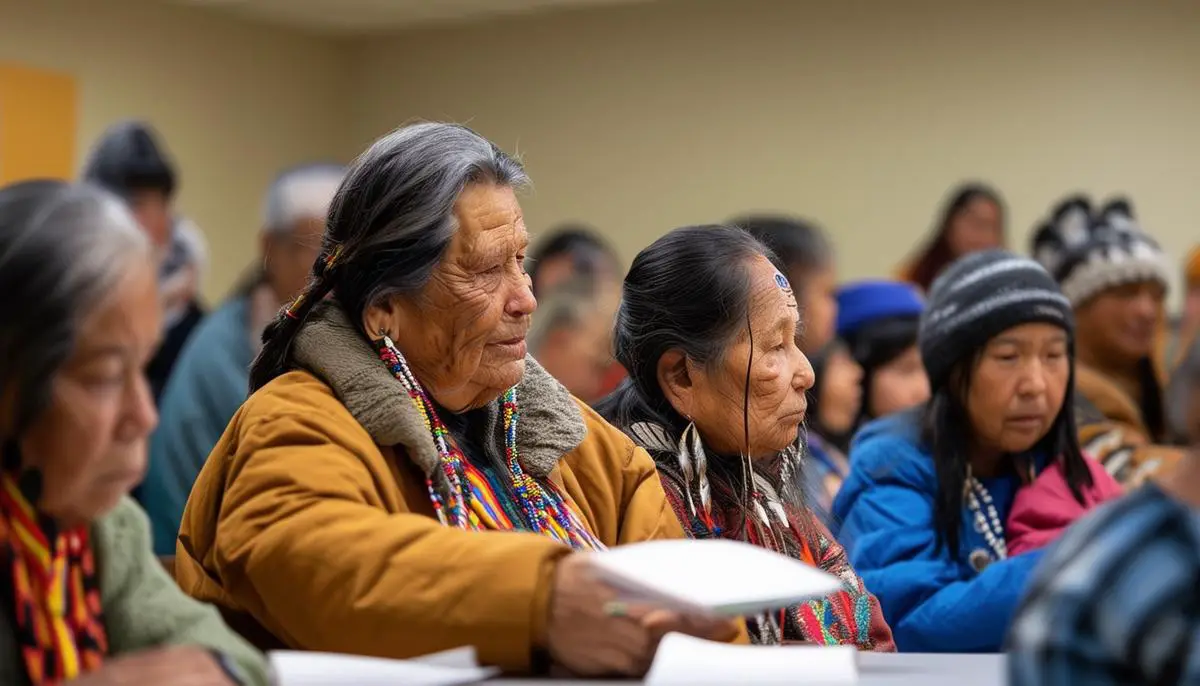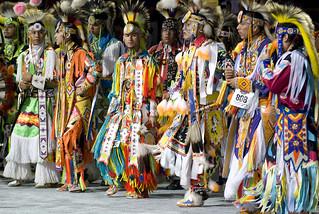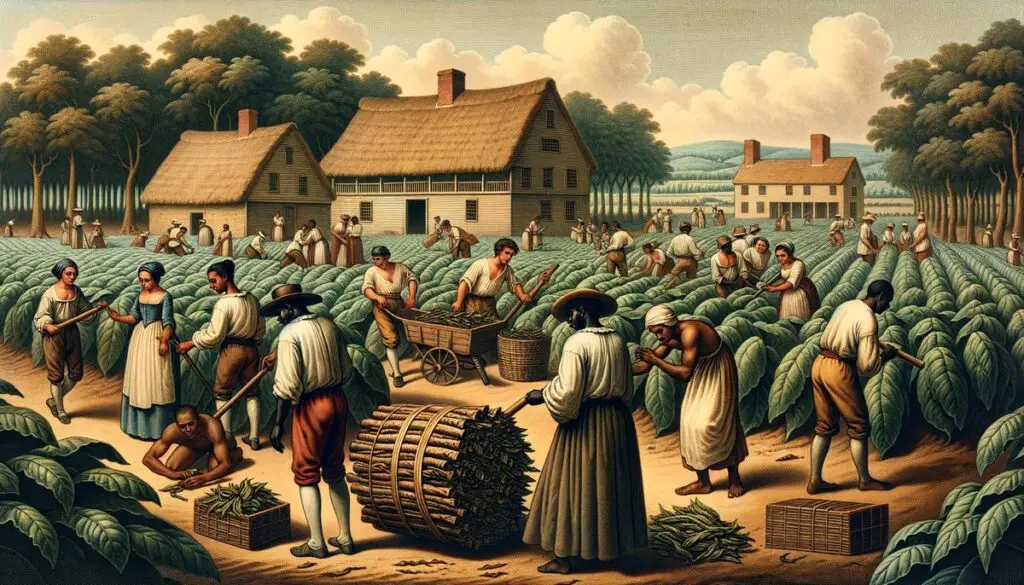Cultural Diversity and Adaptation
Across the expansive landscapes of North America, the array of Native American cultures encompasses thousands of tribes, each with their own intricate traditions, languages, and societal structures. From the dense forests of the Northeast to the arid deserts of the Southwest, these indigenous cultures have persevered and dynamically adapted to the shifting environments and challenges they faced throughout history.
American Indian tribes such as the Navajo, the Sioux, and the Iroquois, representing just a glimpse of the diversity, had developed sophisticated means of interacting with their environments. These practices were inherently sustainable, honed through centuries of observation and adjustment to their lands. Knowledge systems were complex, often passed down through generations verbally and through practice.
With the arrival of Europeans in the late 15th century, these tribal communities confronted rapid and profound changes. The vast networks of trade and communication that once connected various tribes saw disruption. Diseases unknown to the indigenous immune system decimated populations, while concepts such as land ownership introduced by Europeans clashed with the traditional Native belief of a communal living earth.
Yet, Native American tribes responded with resilience. They actively engaged with newcomers, sometimes adopting useful European technologies and forming strategic alliances that reshaped power dynamics. For example, the horse, introduced by Spanish settlers, revolutionized Native American life on the Great Plains, transforming hunting practices and tribal mobility.1
Modern times see tribes navigating a world that simultaneously exists within ancient traditions and contemporary society. The revival of languages and cultural practices that were once suppressed is testament to a broader renaissance of Native American identity and sovereignty. Tribal schools now teach native languages and history as core components of their curriculum, breathing new life into the legacies left by ancestors and ensuring their continuation into the future.
Through legal battles for land rights and political autonomy, American Indians continue to sustain their distinct cultures whilst influencing policy and governance in the United States. This participation embodies their sovereign status and underscores the proactive stance they maintain in shaping their destinies.
The narrative of American Indians is one of great cultural wealth and innovation. Their societies serve as profound lessons in the art of adaptation and the resilience of human communities facing both environmental and man-made pressures. It shadows a heritage that while rooted deeply in history, continually evolves with each generation adapting age-old wisdom to meet modern needs. Whether amidst the bustle of a powwow or in the quiet resurgence of a native language class, the vibrancy and diversity of Native American cultures stand strong, challenging the endless tide of challenges with enduring fortitude.
Historical Impact and Perspectives
Integral to the fabric of the Western Hemisphere's history, Native Americans have exercised significant agency in shaping both the physical and political landscapes from pre-Columbian times through European colonization and into the complex socio-political webs of modernity. Understanding these influences through Native perspectives offers a more nuanced and comprehensive view of history, diverging from Eurocentric narratives that have long dominated the discourse.
Before European contact, vibrant networks of trade, diplomacy, and governance flourished among the myriad Indigenous groups. The Iroquois Confederacy stands as a testament to political sophistication; a union of tribes across the northeastern United States that governed through a system of participatory democracy which predated—and possibly influenced—similar systems in Western societies.2
Their historical impact is not confined to isolated instances of organizational prowess. Through a network of trade routes that spanned the continent, indigenous populations connected in a complex web of economic and social exchanges, fostering regional stability and cultural vibrancy. Their manipulation and stewardship of the environment, achieved through an intimate knowledge of local ecologies, also exemplify their significant impact. The mastery over agriculture noted among groups such as the Mississippians—who constructed the grand city of Cahokia with its vast mounds—or the advanced agricultural practices of the Andean peoples, provided sustainable living models.
The dawn of European colonization marked a pivotal shift in the trajectory of Native American influence. Initial interactions ranged from collaborative trade and cultural exchanges to conflict and resistance. Native American societies were forever altered, grappling with the upheavals of disease and dispossession, while European settlers adopted Native forms of governance, crop cultivation, and survival strategies—all integral to their success in unfamiliar territories.
As centuries progressed, the persistence of Native American nations to maintain their land, culture, and political autonomy, despite systemic oppression and marginalization, continued to shape legislative and cultural frameworks. Landmark events, such as the formation of modern treaties and the resurgence of native languages and traditions, underscore their enduring legacy and central role in advocating for indigenous and human rights globally.
Viewing American history through Native perspectives helps unravel monocultural threads of history to reveal a rich tapestry of interaction, resistance, adaptation, and influence embodied in contemporary movements to reclaim indigenous spaces. Land recoveries, revitalizations of native languages, and assertive sovereignty claims continue to reshape societal structures.
Native American history is inseparable from the broader historical tapestry of the Americas. Their stories and legacies extend beyond mere footnotes in textbooks to the very heart of how the Western Hemisphere's past is understood and its future envisaged. This paradigm shift enhances historical accuracy and heightens respect for and recognition of the profound legacies created by Native Americans across centuries—a narrative of resilience, revitalization, and unwavering strength amid shifts and tumults directed by colonial impacts.
Kinship, Identity, and Social Structures
In the social tapestry of Native American tribes, kinship and extended family relationships are core components structuring individual and community identities. These intricate systems of familial relations extend beyond mere biological connections, serving as foundational principles that guide social behavior, responsibilities, rights, and societal roles within the tribe. For many tribes, kinship dictates methods of inheritance, ceremonial roles, and obligations towards elders and children, weaving a connected community where each member has a recognized place and duty.
Traditional kinship ties usually involve complex networks and may incorporate members outside the immediate nuclear family, incorporating clan systems that are integral to community cohesion. These clans often conform to larger tribal myths and hold significant spiritual authority, which can dictate everything from marriage rules to ceremonial participation. For instance, in tribes with matrilineal systems, such as the Cherokee, identity, property, and lineage are traced through mothers.3 Elders play an especially pivotal role as the bearers of cultural knowledge, history, and spiritual wisdom, significantly influencing younger generations.
The disruption brought by European colonization posed profound challenges to these kinship systems. Forced relocations, such as the Trail of Tears, scattered many tribal members far from their homelands, often breaking apart established community and family structures. Boarding schools aimed at assimilating Native American youth further strained these bonds by removing children from their families and deliberately suppressing indigenous languages and cultural expressions.
Despite these pressures, Native American tribes have showcased remarkable resilience and adaptiveness. In modern contexts, while many continue to honor traditional roles and lessons derived from their elders, there has been a necessary adaptation to preserve these structures. Use of digital communications, social media, and more public platforms for cultural engagement offer new ways to maintain and rebuild kin-based connections. Contemporary powwows, community meetings, and online forums feature discussions around key aspects of kinship, reinforcing communal ties and cultural identity.
Tribal governance often integrates traditional kinship values into contemporary frameworks. This involves honoring treaties, cultural preservation acts, and modern legal systems to assert tribal rights and sovereignty—a reflection of the enduring strength of kinship ideals. Tribal nations have also taken decisive steps to rejuvenate indigenous languages and cultural practices, again affirming the crucial role of families and clans in maintaining the societal fabric.
Ultimately, in weaving the old with the new, Native American communities persist in reinforcing their identity and kinship structures—a fundamental aspect of their heritage that reflects a deep-rooted resilience. This revival helps in preserving important traditions and empowers individuals within the community to continue shaping their identity in synch with both ancestral values and modern realities. Thus, Native American kinship systems, though tested by time and tumult, remain vibrant and essential, continuously adapting to cultivate a resilient and interconnected community identity that holds the past while embracing the future.
Governance and Sovereignty
The evolution of Native American governance systems encapsulates a long history shaped by diverse tribal cultures, each with their own approaches to governing social and political life prior to European contact. These governance systems ranged from large structured governments, such as the extensive political alliance of the Iroquois Confederacy in what is now upstate New York, which operated under what is often considered as one of the earliest democratic systems, to the decentralized network of families and clusters in tribes like the Apache.
Historically, governance among Native American tribes often involved consensual leadership rather than hierarchical rule. Leadership roles were filled based on criteria such as consensus, spiritual significance, and demonstrable skill, particularly in mediation and war. Councils comprising elder members were common, serving as a collective governing body that balanced individual authority with communal input.
The onslaught of European colonization intruded drastically into these established systems. Colonial policies aimed at assimilation, religious conversion, and land appropriation disrupted traditional governance. Treaties and laws were often implemented without the full comprehension or voluntary agreement of native groups, leading to significant loss of land and sovereignty. Practices such as the creation of reservations shattered the spatial and social dimensions integral to Indigenous governance, rerouting traditional political structures into federally imposed governance systems.
Yet, the imposition of external governance sparked a distinct form of resilience and adaptation among native tribes. Over the centuries, many tribes have navigated the colonization impact by hybridizing their historical governance practices with the demands of modern nation-states. Today, many tribes operate under self-written constitutions; some even replicate models similar to the U.S. government with distinct executive, legislative, and judicial branches. For instance, the Cherokee Nation has transitioned from a traditional clan-based society to a complex constitutional government which is fully operational under contemporary international legal standards.4
Ongoing sovereignty issues remain at the forefront of Native political agency. Native American tribes consistently assert their status as sovereign nations, a concept inherent before European contact and recognized—though often contentiously—in various treaties and federal laws. Legal battles over land rights, resource management, and sacred sites have become arenas where sovereignty is both challenged and reaffirmed. Tribal nations leverage these treaties to negotiate their standing amidst state and federal jurisdictions.
The fight for recognition is not confined to land and law alone, as cultural sovereignty—control over one's own cultural heritage and practices—is also vitally pursued. Reclaiming artifacts, human remains, and intellectual property from global institutions have turned into pivotal aspects of Indigenous sovereignty acts.
Indigenous governance today embodies the complex interweaving of traditional customs with the demands imposed by centuries of colonization. This blended approach continues to challenge prevailing stereotypes about native political structures. It represents a robust commitment to reviving and sustaining native sovereignty and highlights a trajectory of self-determined governance that endeavors to fight for cultural respect and political relevance in modern society.
Economic Systems and Trade
Across the vast expanses of pre-Columbian America, Native American tribes engaged in a broad variety of economic activities tailored to their environments. Sophisticated understanding of local ecosystems allowed tribes to flourish across diverse habitats, from the arid southwest deserts to the lush Great Lakes region. This extensive array of traditional tribal economies was marked by a reliance on hunting, gathering, agricultural practices, and later, extensive trading networks that connected disparate communities across regions.
Indigenous people nurtured and developed expansive trade routes that allowed for the exchange of goods, ideas, and cultural practices. These overland and waterborne routes facilitated robust trade systems that linked various regions. Goods such as:
- Copper from the Great Lakes
- Obsidian from the Rockies
- Shells from the Gulf Coast
These were commonly traded items, demonstrating a complex understanding of both regional resource management and intertribal economics.
Crops such as maize, beans, and squash—often referred to as the "Three Sisters"—were cultivated symbiotically, a method enhancing soil fertility and yielding high-productivity farms that supported denser populations and complex societies. These agricultural systems profoundly shaped the economic foundations of tribal societies and are still admired for their ecological sensitivity and sustainability.
The arrival of Europeans marked a dramatic shift in the traditional economic paradigms of Native societies. New goods, technologies, and diseases reshaped the landscape of Indigenous economic activity. Horses, introduced by the Spanish in the 16th century, transformed Plains Indian culture through innovations in mobility and hunting, yet European alliances and trading practices introduced elements of dependency, manipulation, and conflict that were previously foreign to most tribal relations.1
Today, Native American tribes continue to build on their heritage of economic adaptiveness and innovation, engaging in a variety of modern economic ventures that simultaneously respect traditional values and integrate into the global economy. Many tribes operate successful enterprises ranging from cultural tourism and casino operations to managing natural resources and engaging in modern agriculture and technology. Energy production, particularly from renewable resources like wind and solar, plays an increasingly significant role in tribal economies, reflecting ancient values of environmental stewardship.
Tribes have progressively gained legal ground in asserting control and management rights over natural resources on tribal lands. These gains solidify economic bases and reinforce tribal sovereignty.
By actively managing their resources in accordance with contemporary market demands while upholding their cultural and traditional understanding of stewardship, American Indian communities showcase a unique capacity for economic innovation. This approach balances growth with sustainability, ensuring both cultural preservation and economic vitality for future generations.
Preservation of Culture and Knowledge
Native American communities have embarked on efforts to preserve and revitalize their languages, traditions, and indigenous knowledge systems. These undertakings are vital for cultural preservation and for empowering community identity and asserting sovereignty in discussions on indigenous rights and resource management.
Language revival is a pressing focal point of these cultural preservation efforts. Numerous North American tribes have seen declines in native language fluency, raising fears of language death and subsequent cultural loss. In response, tribes have established language preservation programs, involving:
- Community classes
- Digital language resources
- Immersion schools aimed at empowering new generations of fluent speakers
Alongside language, the perpetuation of traditional crafts and ceremonies plays a crucial role in maintaining and transmitting Native American cultural legacies. Art forms like basket weaving, pottery, beadwork, and dance are artistic expressions laden with cultural significance as narrators of tribal history and spirituality. Tribal museums and cultural centers act as bastions for these arts, offering workshops and educational programs that facilitate skill transmission from elders to youths.
The replication of traditional food systems is an enhanced facet of cultural preservation. Crop cultivation techniques such as the "Three Sisters" are being revitalized, fostering nutritional benefits attached to heritage crops while maintaining spiritual and environmental practices embedded within traditional agricultural knowledge. This resurgence revitalizes ancestral agricultural techniques and reinforces food sovereignty.
The digital era has encouraged innovative methods for archiving knowledge and connecting communities. Several tribes use digital archives to safeguard oral histories, ceremonial details, and genealogies, ensuring accessibility for future generations. Virtual platforms facilitate a broader communal bridge linking disperse Native populations through shared online environments.
However, these efforts face challenges. Financial constraints significantly hamper many tribes' ability to fund comprehensive preservation projects. Legal battles often challenge tribal control over sacred sites and intellectual property. There's an ongoing need to balance the integration of modern technologies in preservation efforts with maintaining the authenticity of traditional practices.
Despite these challenges, contemporary successes offer beacons of hope and models for preservation. Initiatives such as the recent return of ancestral remains and sacred artifacts, repatriated to tribes after long periods housed in museums abroad, manifest vital victories in cultural reclamation efforts.2
The drive to preserve and rejuvenate Native American cultures is a confrontation against the erasure of cultural memory. By investing in these endeavors, Native communities reinforce their legacies, not as relics of the past but as vibrant lifelines steering them into the future. This proactive stance enriches Native American societies and creates narrative spaces that reverberate with resilience, continuity, and vibrancy.

The ongoing efforts to preserve and revitalize Native American cultures are affirmations of identity and sovereignty. These endeavors enrich the communities directly involved and contribute to the global cultural landscape, ensuring that these vibrant traditions continue to influence future generations.
- Native American History - April 27, 2024
- Lewis and Clark Expedition - April 26, 2024
- American Revolution Overview - April 25, 2024




